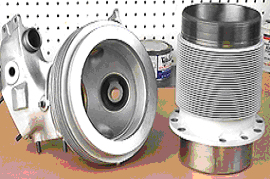No. AV-2007-02
01 February 2007
The R-985 engine (Wasp Junior) is an air-cooled, supercharged, 9-cylinder single row radial engine that entered service in 1932 and was later used in thousands of various military aircraft during World War II. Shortly thereafter, the R-985 engine entered commercial service on the aircraft such as the DHC 3 (Beaver) and the Beechcraft 18 (Expeditor). This engine remains in active and productive service.
Transport Canada Civil Aviation (TCCA) has recently conducted an in-service review to identify the more common defects/failures and malfunctions associated with the R-985 engine. A 10-year SDR search clearly identified the three major problems to be (1) cylinder head to cylinder barrel separation (2) cylinder barrel flange cracks (3) crankcase to cylinder barrel hold-down studs/nuts.
Although the following FAA Airworthiness Directives were issued some time ago, the mandatory instructions and required actions contained therein remain effective.
FAA AD 56-06-02 was issued to provide maintainers and operators specific technical instructions (Visual and Magnaflux inspections) in order to address problems associated with cylinder barrel flange distortion and/or cracks. This AD also provides guidance and parameters with respect to cylinder flange hold-down studs and/or nuts. P&W SB 1000 describe the approved procedure to secure the cylinder flange attaching nuts.
FAA AD 78-08-07 was issued to help detect and prevent separation of the cylinder head and cylinder barrel. Inspection of the cylinder assembly (Visual and Ultrasonic inspection) was mandated to detect and then remove cracked cylinders that exceeded specified limits.
Cylinder heads usually fail when the tensile strength of their material has been lowered by excess heat.
Furthermore, the majority of the heat developed within the engine is carried to the atmosphere through the exhaust valve, thus valve timing, seating and clearances must be correct. If the exhaust valve does not open at precisely the right moment, then the exhaust gases will not leave the cylinder at the right time. Consequently, heat and internal pressures continue to increase and be transferred to the walls of the combustion chamber and cylinder.
Maintainers and operators should pay frequent attention to the area of the cylinder head cooling fins for exhaust emission stains that could be an indication of a crack developing. If exhaust deposits are found, wipe clean and monitor closely for cracks. Oil stains around the area of the cylinder barrel and crankcase could be an indication of a crack. Additionally, the area of the spark plug bushings and rockerbox area must be monitored for cracks.
Before installing the cylinder assembly onto the crankcase, thoroughly clean the threads of the studs and inspect for looseness and fractures at the base of the threads. Also check the studs for straightness, nicks, burrs and closely inspect the thread condition of the nuts. When installing the cylinder assembly to the crankcase mounting pads (power section), make sure to use the approved and specified PWA Handle (referenced in the Wasp Jr. and Wasp Maintenance Manual) and tighten the hold-down nuts evenly to ensure even load distribution around the cylinder flange. Tighten the hold-down nuts to the recommended torque; install palnuts (running down finger tight) and then ¼ turn over the hold-down nuts.
It is very important that operators properly warm-up and cool-down the engine before and after flight. This will significantly minimize distress to the engine. It is essential that the cylinder assembly be adequately warmed up in order to “heat stretch” the cold cylinder, especially before applying high power. Failure to do so can lead to fatigue cracks and cause distress to the cylinder head and other rotating parts of the engine. Problems associated with cylinder head separation and cylinder barrel flange cracks can be minimized if attention to cylinder head temperature limitations is closely followed.
Adherence to the R-985 Specific and General Operating Instructions (Vol 1) is essential, in particular:
- While ground testing engine, do not exceed 232 degrees Celsius cylinder head temperature. Temperatures above 200 degrees C should be confined to the minimum possible duration.
- Prior to Take-Off, ensure that cylinder head temperature is below 200 degrees Celsius to allow for temperature rise during takeoff.
- Do not exceed 260 degrees Celsius during Climb and reduce cylinder head temperatures to below 232 degrees for Cruise flight
- Following flight and before shutdown, idle the engine until cylinder head temperature is less than 200 degrees Celsius
Operators and maintainers must take every precaution to avoid operating at excessive cylinder head temperature and excessive manifold pressure or incorrect (MAP) manifold absolute pressure-rpm ratios. These conditions will likely overstress the cylinders and other engine parts. Excessive cylinder pressures and cylinder temperatures usually result in detonation, pre-ignition and loss of engine power. This can lead to failure of cylinder base studs, flange cracks and/or separation of the cylinder head from the barrel.
A prominent domestic radial engine overhaul company (AMO) has introduced improvements at the interface threads that secure the cylinder head to the cylinder barrel. This thread restoration technique has greatly reduced occurrences of cylinder head separation and leaks. A 1000-hour warranty is given on this new interference fit. Over 5000 cylinders assemblies have modified and routed to customers and only a few cylinders have been returned for warranty action.
Cylinder Head and Flange
The basic TBO of the R-985 is 1200 hours with a possible approved extension to a maximum of 1600 hours.
In accordance with CAR 591, any defects, failures or malfunctions should be reported to Transport Canada, Continuing Airworthiness via the Service Difficulty Reporting program.
For further information, please contact a Transport Canada Centre, or contact Mr. Barry Caldwel at 613-952-4358, facsimile 613-996-9178 or e-mail caldweb@tc.gc.ca
For Director, Aircraft Certification
Robin Lau
Acting Chief, Continuing Airworthiness
Chef intérimaire, Maintien de la navigabilité aérienne
Note: For the electronic version of this document, please consult the following Web address: https://tc.canada.ca/en/aviation/aircraft-airworthiness/aircraft-certification
